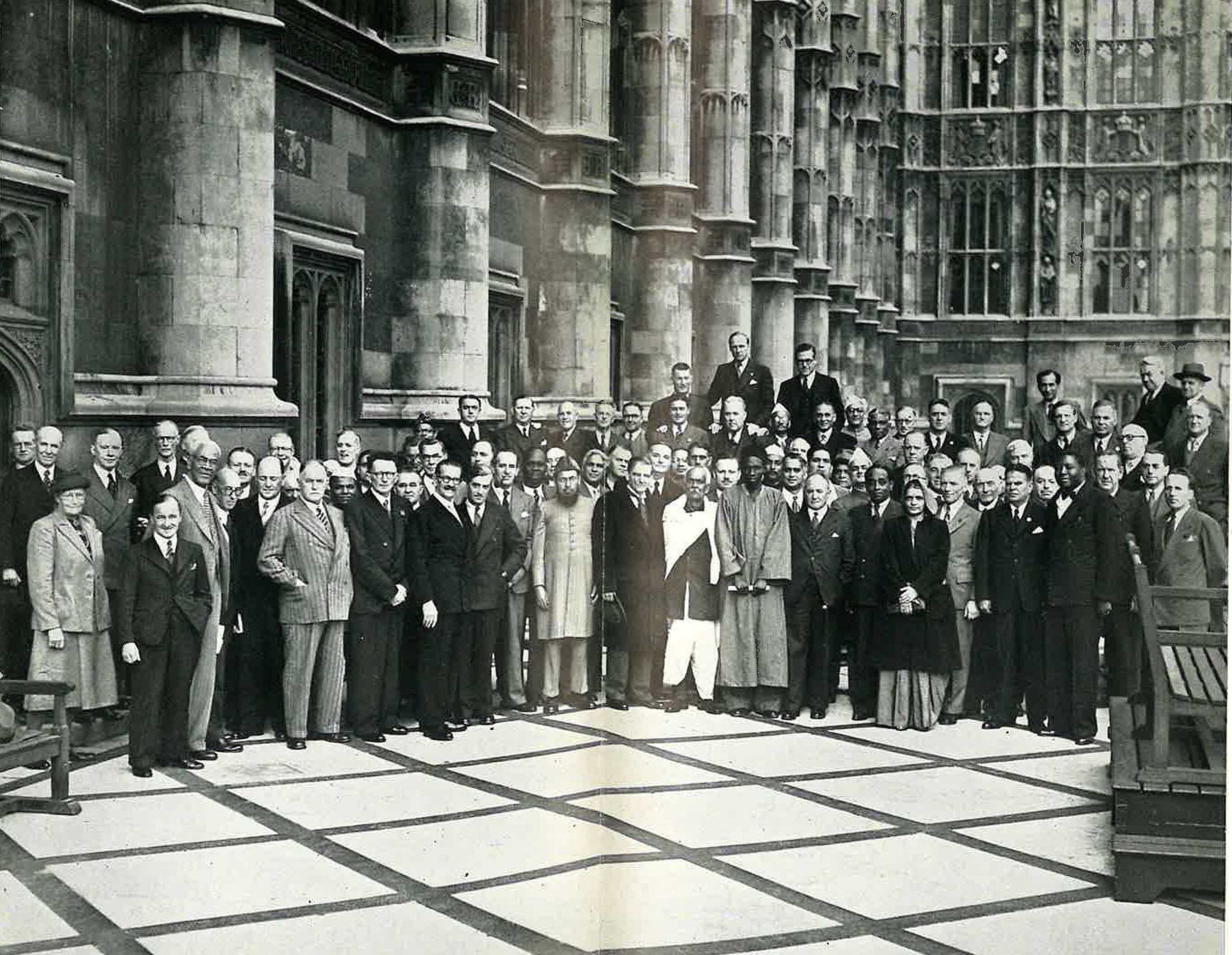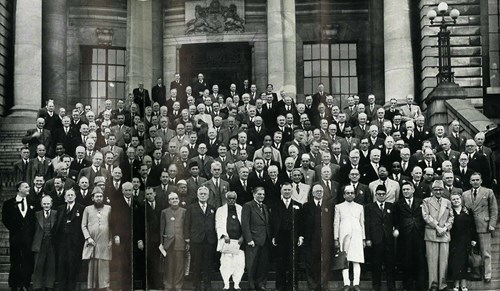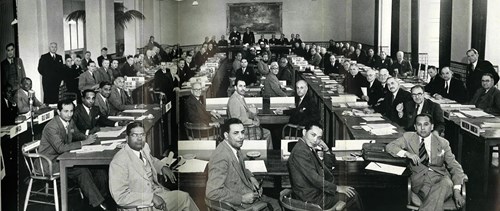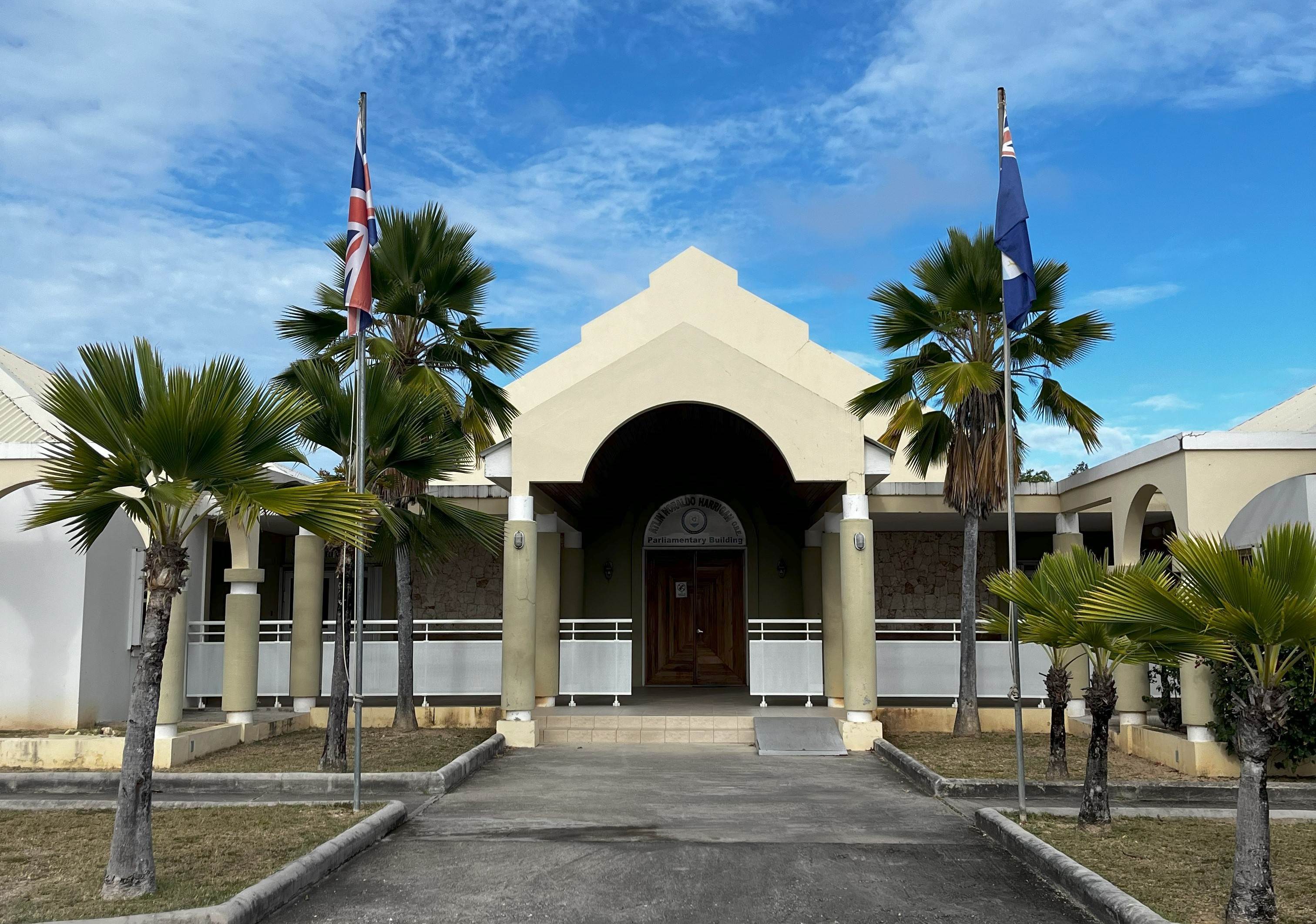
How did the events of 1948-50 affect the creation of the ‘modern’ Commonwealth?
This blog brings together a historical perspective of the establishment of the ‘modern’ Commonwealth Parliamentary Association in 1948-50 and the growth of the CPA over the last 75 years.
This blog article brings together a historical perspective of the establishment of the ‘modern’ Commonwealth Parliamentary Association in 1948-50 and the events at the time. This blog also looks at the growth of the Commonwealth Parliamentary Association over the last 75 years.
Article by Research Intern, Maddie Rafferty posted on 22/04/2024
Introduction
As the Commonwealth marks its 75th anniversary on 26 April 2024, it is fitting to reflect on the Commonwealth Parliamentary Association (CPA) over the last 75 years. In this blog post, we will look at the transition from the Empire to the Commonwealth, what this meant for the CPA and how the CPA has continued its purpose up to the present day.
PART ONE:
Building the Commonwealth

The Speaker of the Lok Sabha of the Parliament of India, Hon. Seth Govind Das, was a delegate at the 2nd Commonwealth Parliamentary Conference (CPC) in 1950 held in Wellington, New Zealand, and he wrote in his account of the conference titled ‘On Wings to the ANZACS’:
“The old body obviously did not fit in well with the changed circumstances and were not only out-of-date but also out-of-tune with the political views and aspirations of the Commonwealth people.” – Seth Govind Das, ‘On Wings to the ANZACS' p.5.
Creating the Commonwealth as we understand it today was an incremental process. The transition to the Commonwealth of Nations became official in April 1949 with the London Declaration, but it was preceded by and built upon the 1931 Statute of Westminster and the Balfour Declaration of 1926.
The Empire Parliamentary Association had originally been founded in 1911 and had played a key role in convening Parliaments for these declarations in the periods both pre- and post-First World War. The Empire Parliamentary Association’s transition to the Commonwealth Parliamentary Association in 1948, however, pre-dated the ‘official’ governmental establishment of the ‘modern’ Commonwealth in 1949, with the purpose of introducing an Association based on equality, peace and co-operation for governments to follow.
This transition to ‘modern’ Commonwealth signalled a change in attitudes towards the former Empire, seeing the decline of Britain as a paternalistic figure and instead it began the era of greater equality and co-operation between the countries and nations of the new Commonwealth.
“We believe that the word ‘Commonwealth’ is a better word in spirit and accuracy to use in describing this extraordinary assembly of nations than the words ‘British Empire’... I would say that the spirit of unity and common purpose in the Commonwealth today and the wish to agree are, I should be inclined to think, greater than they ever were in the history of this great community of nations.” - Lord President of the Council and Leader of the UK House of Commons, Rt Hon. Herbert Morrison, MP (Lewisham), 1948 Journal of Commonwealth Parliaments, p. 531.

Above: King George VI met with the Heads of the ‘new' Commonwealth nations at the time of the London Declaration in 1949 when he became the first ‘Head of the Commonwealth’ (image copyright: Commonwealth Secretariat).
1948-50: A new era for the CPA
In a post-World War Two era, the Members of the Empire Parliamentary Association felt that they needed to establish a camaraderie, equality and modernisation within the organisation to ensure a unified and functional Association. ‘Commonwealth', as opposed to ‘Empire', embodied the spirit and community that the Association was searching for; and so, the Commonwealth Parliamentary Association was born after a resolution was introduced by the Canadian Parliamentary Association in February 1948, which was accepted by the General Council, the governing body at the time. Later that year, the official name change took place for the Association at what would be the first Commonwealth Parliamentary Conference held in London in October 1948.
Calls also came earlier from the Republic of Ireland’s Branch of the Association in 1947, spearheaded by Mr James Dillon (Teachta Dála for Monaghan) as the Members of the Irish Parliament debated their continuing membership within the Commonwealth and the Empire Parliamentary Association. In the same year, the House of the Oireachtas (Parliament of Ireland) removed the word ‘Empire’ from the title of the Journal of Parliaments of the Empire that were distributed in Ireland.
Similarly, in 1947 the India Union Branch passed a resolution suggesting the Association’s name be changed to the Commonwealth Parliamentary Association.
Although overwhelmingly accepted by the organisation, there was some initial opposition to the change in name of the Commonwealth Parliamentary Association. The Commonwealth was seen by many as a more inclusive and inviting term, while others opposed the name change, preferring to maintain the tradition and grandeur that was associated with Empire.
A primary concern for the Speaker of the India Parliament, Hon. G.V. Mavalankar, MCA during discussions at the 1948 Commonwealth Parliamentary Conference was that a change of name would not bring about a change of attitude.
“If it is expected that a mere change of name without a change of heart and attitude is going to achieve what we have in view, then I would, with all earnestness at my command, say to this Conference that we are moving in a direction in which success does not lie.” - Hon. G.V. Mavalankar, MCA (Speaker of the Parliament of India) Report of Proceedings of the 1st Commonwealth Parliamentary Conference 1948 – London, p. 131.

Above: Delegates outside the UK Houses of Parliament at they attend the first Commonwealth Parliamentary Conference in London in 1948 (image copyright: Commonwealth Parliamentary Association/UK Parliamentary Archives).

Above: Delegates to the first Commonwealth Parliamentary Conference in 1948 also
visited the port of Liverpool (image copyright: Commonwealth Parliamentary Association/UK Parliamentary Archives).
Next steps for the CPA in New Zealand in 1950
The second Commonwealth Parliamentary Conference was held in Wellington, New Zealand in 1950 and was the first conference in which the transition from Empire to Commonwealth had been made at both the CPA’s institutional level and governmental level. The 1950 Conference was a turning point at which the impacts of a changing organisation could be felt.
Indian MP, Hon. Seth Govind Das noted that the changes from the Empire Parliamentary Association into the Commonwealth Parliamentary Association brought the organisation into much greater harmony with the changing political views, aspirations and corpus of the Commonwealth. It was also in Wellington, at a Meeting of the Association’s General Council, that the first Constitution of the Commonwealth Parliamentary Association was presented and passed.
“The General Council – we meet entirely as equals” - Chairman of the meeting, Senator Hon. A.W. Roebuck, KC (Canada), Report of Proceedings at the General Meeting Held in Wellington, New Zealand, 21st November 1950, p. 46.

Above: Delegates at the second Commonwealth Parliamentary Conference in Wellington are pictured outside of the Parliament of New Zealand in 1950 (image copyright: Commonwealth Parliamentary Association/UK Parliamentary Archives).
“…the Parliamentarians representing each country comprising the Commonwealth should understand the difficulties and problems and the circumstances of the other countries of the Commonwealth.” - Hon. M.H. Oram MBE, MP, Speaker of the New Zealand House of Representatives, Report of the General Council 1950-51, p.11.

Above: Delegates at the second Commonwealth Parliamentary Conference in 1950 are pictured during their deliberations in New Zealand (image copyright: Commonwealth Parliamentary Association/UK Parliamentary Archives).
PART TWO:
The growth of the Commonwealth Parliamentary Association over the last 75 years
Over the last 75 years, the Commonwealth Parliamentary Association (CPA) has undergone many transformations with 8 different CPA Secretaries-General, at least 48 countries who have transitioned to independence, and almost 180 CPA Branches formed in nine Regions.
Despite these many changes, the fundamental tenets of the CPA of “promot[ing] understanding and co-operation” (as set out in the 1950 CPA Constitution) remain.
Here are some of the key highlights:
- 1949
It was in 1949 that the Journal of the Parliaments of Empire (first published in 1920) became the Journal of the Parliaments of Commonwealth, one of the final stages of the transition between the Empire Parliamentary Association and the Commonwealth Parliamentary Association. The new name of the Journal helped to solidify the new identity of the Association. However, this would not be the final name change for the Journal. In 1966, the Journal of the Parliaments of the Commonwealth would become The Parliamentarian, as it is known today.
Read our online archive of The Parliamentarian.

- 1950
The first CPA Constitution was passed by Members attending the second Commonwealth Parliamentary Conference in New Zealand.
- 1953
Queen Elizabeth II attended a special Coronation reception and luncheon for CPA Members held in Westminster Hall in the UK Parliament (pictures from Coronation Luncheon). The Queen would take an active interest in the Commonwealth Parliamentary Association and opened several of the annual CPA Conferences.
In 1989, Queen Elizabeth II as Head of the Commonwealth also became the first Patron of the Commonwealth Parliamentary Association, and as Patron opened the 46th Commonwealth Parliamentary Conference held in London in 2000.

Above: Queen Elizabeth II with Commonwealth Leaders at the time of her Coronation in 1953 (image copyright: Commonwealth Secretariat).

Above: Queen Elizabeth II addresses Members of the Association at the CPA Coronation reception in Westminster Hall in 1953 (image copyright: Commonwealth Parliamentary Association).

Above: Queen Elizabeth II visiting the Parliament of Singapore in 1989, the year she became Patron of the Commonwealth Parliamentary Association (image copyright: Commonwealth Parliamentary Association/Parliament of Singapore).

Above: Queen Elizabeth II opening the 46th Commonwealth Parliamentary Conference held in London in 2000 (image copyright: Commonwealth Parliamentary Association).
- 1957
In this year, Ghana was one of the first African nations to transition to independence and its Parliament would become a CPA Branch. The Parliament of Ghana would play an active role in the Association over the years and hosted the 66th Commonwealth Parliamentary Conference in Accra in October 2023.
- 1959
The 6th Commonwealth Parliamentary Conference was held in Australia, the first time that it had been held in the country, and since then the Conference has been held in the CPA Australia Region three more times. The next Commonwealth Parliamentary Conference will be held in New South Wales, Australia in November 2024 to mark the bicentenary of the New South Wales Legislative Council.
- 1961
In this year, the Commonwealth Parliamentary Conference would become an annual event.
- 1981
The CPA Small Branches network was created, at the suggestion of the CPA Jersey Branch, when the first annual CPA Small Branches Conference for Commonwealth Parliamentarians was held to promote co-operation and share best practice amongst the smallest jurisdictions. The CPA Small Branches network now has more than 40 Branches with a population of up to one million people each. However, many island nations have under 100,000 people and some CPA Branches have less than 10,000 people.

Above: A CPA workshop for Small Branches on disaster risk management held in May 2023 (image copyright: Commonwealth Parliamentary Association).
- 1981
The CPA Fiji Branch was the first CPA Small Branch to host a CPA Annual Conference when they hosted the 27th Commonwealth Parliamentary Conference and 1st CPA Small Branches Conference. Since then, several CPA Small Branches have hosted the Annual Conference including The Bahamas (three times), the Isle of Man and Barbados.
- 1989
The first informal meeting of women Parliamentarians was held at the 35th Commonwealth Parliamentary Conference held in Barbados in 1989, initiated by Senator Norma Cox Astwood (Bermuda). In 1996, the group of women Parliamentarians within the CPA came into formal recognition as the Commonwealth Women Parliamentarians (CWP) under a series of appointed CWP Chairpersons between 1996 and 2004 when the first CWP Chairperson was elected.

Above: Meeting of Commonwealth Women Parliamentarians delegates at the 66th Commonwealth Parliamentary Conference held in Ghana in October 2023 (image copyright: Commonwealth Parliamentary Association).
- 1996
Hon. Billie Miller, MP (Barbados) became the first female Chairperson of the CPA Executive Committee (until 1999) and the fourth from the CPA Caribbean, Americas and the Atlantic Region.
- 1997
The first Commonwealth Youth Parliament was held in 1997 in Manchester in the United Kingdom. Many Commonwealth Parliaments hold Youth Parliaments to engage with young people and create opportunities for youth representation. Commonwealth Youth Parliaments have since been hosted in the United Kingdom, Australia, Trinidad and Tobago, India, Jersey, Canada and South Africa.
Several former Youth Parliamentarians have gone on to careers in Parliaments around the Commonwealth. For example, after representing the island in the 9th Commonwealth Youth Parliament in 2018, Hon. Michelle Slack became the President of the Nevis Island Assembly and one of the youngest Presiding Officers in the Commonwealth.

Above: The most recent in-person event was the 11th Commonwealth Youth Parliament hosted by the Parliament of Trinidad and Tobago (image copyright: Commonwealth Parliamentary Association) .
- 1999
50 years of the Commonwealth was marked by Commonwealth organisations including the CPA and Commonwealth Leaders gathered in South Africa for the Commonwealth Heads of Government Meeting (CHOGM) in Durban. In this year, the CPA held 45th Commonwealth Parliamentary Conference and 19th CPA Small Branches Conference in Trinidad and Tobago.
- 2011
The centenary of the Commonwealth Parliamentary Association was marked in 2011. HRH The Princess Royal represented the CPA’s Patron, Queen Elizabeth II, at the opening ceremony of the 57th Commonwealth Parliamentary Conference and the 31st CPA Small Branches Conference in London, United Kingdom.
“We no longer live in a world of super powers but in a world of networks and friendships – and that makes the Commonwealth as relevant as it has ever been” - Former United Kingdom Prime Minister, Rt Hon. David Cameron, MP, 2011 The Parliamentarian p.238. Quoted from Plenary Session of 57th CPC in London, July 2011.

Above: HRH The Princess Royal addresses delegates at the opening ceremony of the 57th Commonwealth Parliamentary Conference in London in 2011 (image copyright: Commonwealth Parliamentary Association).
- 2019
The Commonwealth Parliamentarians with Disabilities (CPwD) network is the most recent to be established in the CPA. It was created “to encourage Commonwealth Parliaments to enable effective and full participation of persons with disabilities at all levels” (CPwD mission statement). The CPwD has online resources, funding and toolkits to increase accessibility and inclusivity in Commonwealth Parliaments.

Above: The CPwD Regional Champions visit the Accra Rehabilitation Centre in Ghana to learn about their work supporting persons with disabilities in October 2023 (image copyright: Commonwealth Parliamentary Association).
- 2019
The 70th anniversary of the ‘modern’ Commonwealth was celebrated with a Commonwealth Day theme of ‘A Connected Commonwealth’. A special issue of The Parliamentarian was published to mark the occasion.
- 2020
In this year, Stephen Twigg started his term as the 8th and current Secretary-General of the Commonwealth Parliamentary Association. He is a former UK Parliamentarian and Chair of the International Development Committee.
The role of Secretary-General was created at the first Commonwealth Parliamentary Conference in 1948, with the appointment of Sir Howard D’Egville. There have since been eight CPA Secretaries-General, hailing from six of the nine CPA Regions (Africa, Australia, British Islands and Mediterranean, Canada, Caribbean, Americas and the Atlantic and Pacific). To date, no woman has held the role of CPA Secretary-General.
In a recent issue of The Parliamentarian, the current CPA Secretary-General wrote about The Commonwealth in the 21st century and the role of the CPA.

Above: Portraits of the first six Secretaries-General at the CPA Headquarters in London. Sir Howard D’Egville (1949-1960), Sir Robin Vandervelt (1961-1985), Dr David Tonkin (1986-1992), Mr Arthur Donahoe (1993-2001), Mr Denis Marshall (2002-2006), Dr William F. Shija (2007-2014) - (image copyright: Commonwealth Parliamentary Association).
Current CPA Secretary-General, Stephen Twigg reflects on his role:
“I joined the CPA as its 8th Secretary-General in 2020. Previously, I had been a Member of Parliament in the United Kingdom. I had chaired the cross-party International Development Committee, and I was keen, after leaving Parliament, to have a role which worked internationally.
When I joined the CPA, the immediate challenge was the COVID pandemic and the need to adapt to a world of lockdowns and restricted travel. The CPA’s membership, staff and partner organisations responded well to this challenge. I had two other key priorities – to develop and implement a new Strategic Plan and to resolve the longstanding matter of the CPA’s legal status.
I will start my second term in August 2024 and I am looking forward to the opportunity to build upon the work of recent years. Everything at the CPA is a team effort and I am grateful to our amazing Secretariat staff, the Members of the CPA Executive Committee and the wider CPA membership for their hard work and commitment to the Association.”
- 2024
The UK Parliament welcomed Commonwealth Speakers to Westminster for the Commonwealth Speakers Summit 2024 to mark the 75th anniversary of the Commonwealth and to coincide with Commonwealth Day.
This meeting evoked memories of the 1950 reopening of the UK House of Commons Chamber after it was destroyed due to bombing during the Second World War. At that time, Commonwealth Speakers were invited to attend the first sitting of the new Chamber in 1950 and 45 Commonwealth countries gifted items and materials to rebuild the UK House of Commons after it was destroyed.
In 2024, the UK Parliament’s Heritage team created an exhibition for Commonwealth Day showcasing the special gifts from Commonwealth nations and territories that still feature today in Westminster.
See all of the Commonwealth gifts to the UK’s House of Commons since 1950.

Above: Commonwealth Speakers gathered for the reopening of the UK Parliament in 1950 (image copyright: UK Parliament).

Above: In 2024, Commonwealth Speakers and Presiding Officers attending the Commonwealth Speakers Summit visit the current UK House of Commons Chamber (image copyright: UK Parliament).
The past seventy-five years has seen the Commonwealth Parliamentary Association develop into an organisation that not only connects Commonwealth Parliaments and their Members and parliamentary staff, but also supports their journey to uphold and strengthen parliamentary democracy across the Commonwealth.
Return to the CPA blog series: '75th anniversary of the ‘modern’ Commonwealth'
Follow the CPA on social media to continue the discussion.




